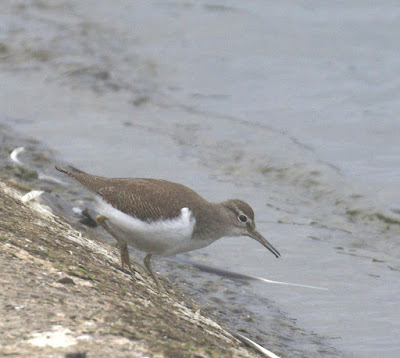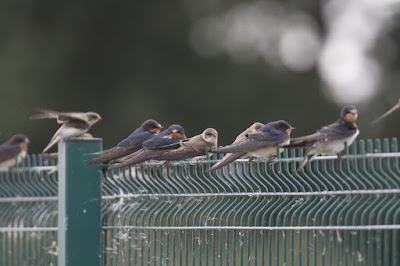A ridiculously tame Red backed Shrike had been found at Newhaven Tidemills in East Sussex a few days ago and proved irresistible as Newhaven was very much my local patch when I lived in Sussex some twenty or more years ago. It would be good to go back and wander my old haunts with the added incentive, if one was needed, of getting close and personal with a Red backed Shrike.
I called John, an old friend who makes a precarious living as a bird artist and lives in Brighton, and with whom I have shared many a good day's birding in Sussex, suggesting I could pick him up on the way through and we could go together to see the shrike. It would be just like old times.
So it was that I collected John from his house some three hours after leaving Kingham and we drove in beautiful sunny weather the comparatively short distance to Newhaven Tidemills which lies at a forgotten, tiny and now virtually vanished village called Bishopstone between Newhaven and Seaford and is situated just a couple of hundred metres from the sea
So it was that I collected John from his house some three hours after leaving Kingham and we drove in beautiful sunny weather the comparatively short distance to Newhaven Tidemills which lies at a forgotten, tiny and now virtually vanished village called Bishopstone between Newhaven and Seaford and is situated just a couple of hundred metres from the sea
The village consisted of a large tide mill and numerous workers cottages, housing around a hundred workers.The tide mill was erected in 1761 by the Duke of Newcastle and later more famously was owned and operated by William Catt and his family from 1770-1853. The mill ceased working around 1900 and the village was condemned as unfit for habitation in 1936 with the residents being forcibly removed in 1939. Newhaven comprised part of the southern defences during the Second World War and the area around the tide mill was cleared to give an uninterrupted field of fire for guns should there be an invasion.The remains of Bishopstone Beach Halt railway station platform still stands adjacent to the pedestrian crossing over the railway line.
All that survives today of the tide-mill and its workers houses are the derelict and forlorn flint foundations of the building's, slowly disappearing under brambles and scrub. Even the railway that runs across it from Seaford to Newhaven and Lewes is now temporarily non operational due to Southern Rail's interminable conflict with the rail unions and their lamentable inability to provide anything like a comprehensive train service. This in turn contributes further to the general air of dereliction that permeates the place but the neglect has its positive birding points in that it has allowed the extensive waste ground, despite occasional threats to develop it from the Port Authority, to become quite a nice area of scrub habitat that is ideal for migrant birds and this is what had undoubtedly attracted the shrike.
The grassy, open area it frequented is augmented with scattered buddleia bushes and large bramble clumps, ideal for a shrike to perch upon and fly down to seize its prey. The odd pampas grass clump with their silky, white, brush like blooms were a less likely addition to the flora but together with the buddleia added a slightly incongruous exotic note to the habitat.
The temporary home of the Red backed Shrike
|
Parking the car on the concrete road adjacent to the rail crossing we walked across the railway lines that were already beginning to rust through disuse and slowly made our way out to the shrike's favoured location which typically was about as far away as possible from the car. John has not been that well recently and has to move slowly due to problems with his leg but gradually we made our way to the far end of the waste ground where we could see a small group of birders and photographers gathered around a particular bush.
Even from afar I could see the distinctive silhouette of the shrike sat on top of the bush. Eventually we got to the shrike and its behaviour exceeded even our wildest expectations. I had been told how tame it was and it lost no time in demonstrating this by flying directly towards us and perching on a bush literally feet from us. It would remain here for a little while looking around in all directions for prey and then when it discerned something to its liking would descend and capture it before returning to its perch to consume it. While we were there we saw it catch a number of bees and beetles and later, after we had left, it apparently caught and killed a vole.
The shrike was a first winter male making its first trip to southern latitudes. They have a long and dangerous migration to accomplish as they spend the winter in tropical Africa south of the Equator. Red backed Shrikes no longer breed in Britain so this bird could be either from Scandinavia, northern or central Europe. I assumed it had stopped here to feed up before heading further south but according to Birds of the Western Palearctic they do not build up fat reserves to assist their migration but opportunistically prey on other small passerine birds as they make their way south.This would explain its lunge at and attempt to catch a Common Whitethroat that strayed into the same buddleia bush that it was perched on.
Its plumage was an attractive combination of pale chestnut upperparts and off white underparts with dark chevrons scattered across the plumage creating a scaly appearance. Its eye was large and dark brown, imparting a deceptively benign appearance but make no mistake this bird was a ruthless killer ever ready to seize and kill anything, even approaching its own size, that strayed too close. Its formidably substantial bill, well able to tackle large prey, was testament to this.
Both of us agreed that we had never seen a shrike that was so confiding. You could follow it around if you wished but if you remained stood on one spot it would sooner rather than later perch within feet of you as it followed a small circuit around the scattered bushes. On one memorable occasion it saw something it fancied at my feet and flew down to within two feet of me, diving into the long grass to seize a beetle. On another occasion it flew towards me and passed so close that I could hear the air passing through its wings.
I was totally enthralled by the shrike as were most others there and we all stood quietly in the pleasant sunshine enjoying this almost unique experience. An hour passed and then it was time to go as I had to be at a business conference that evening in Reading and John was keen to get back to Brighton.
European Stonechat-female
|
We walked back through the scrub encountering a few European Stonechats, Common Whitethroats, Blackcaps and twittering flocks of Goldfinches fussing over the thistle heads.
So farewell once again Newhaven and thanks for all the good times








































































